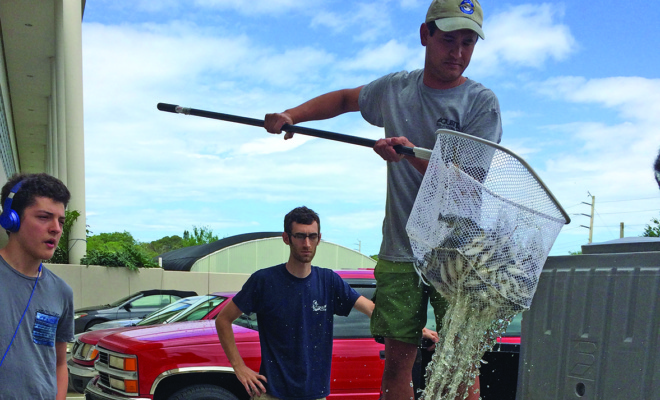
Education
Education Matters
Stars to Starfish to Snook at the Riverview High School AquaDome
By Ryan G. Van Cleave
When my daughter heard I was writing a piece about snook this month, she squealed with delight. She LOVES snook thanks to her class’ participation in Riverview High School’s “Stars to Starfish” program, where she visited their Planetarium and the AquaDome. “They’re adorable little eating machines!” she says about the super-active snook, though she also liked the Touch Tank and (delicately) exploring the saltwater invertebrates with her own hands. While there, her class learned about sustainability, the crucial nature of environmental stewardship, and other Common Core Science Standards. She was especially interested in being able to feed freshwater tilapia and koi, and then watch the student interns handfeed baby sharks!
Her final verdict about her “Stars to Starfish” experience? “Awesome.”
From the very beginning, Mote Marine Laboratory and Aquarium played a role in helping science teacher Karin Rudge’s hands-on marine science opportunities grow from a classroom fish tank to the 32’x72’ aquaculture facility they call the AquaDome that now houses over a hundred aquariums and thousands of fish. “I’ve got a master’s degree in marine science from the University of Maryland,” she explains. “One of my professors was Genie Clark, the founder of Mote. That explains my interest in sharks and marine science.” When she started teaching at Riverview in 2004, she had 40 students in the marine science program. Now it’s grown to 500 students. Those who move on from the first-year honors marine science class and take the second-year one? They get to participate in activities such as the September 2017 snook release, where the snook they’ve been raising in the AquaDome get tagged and released into Philippi Creek. The goal is for Mote to use their tracking stations in the watershed to find out more about their habits and habitats.
Dr. Kevan Main, Director of Mote’s Aquaculture Research Park, says that in addition to supporting the education of potential future marine scientists, they wanted to have local fish available for students to work with. Getting more tank space is an issue, so they welcomed working with the Riverview students and the Aquadome. “It was a logical partnership,” she says. “They were able to raise red fish and snook in their tanks. Some of those fish have come back and been incorporated into our populations here. Some will be released into the wild when they’ve grown large enough.” She points out that it’s important for students to see the entire process from start to finish. They’re involved from growing the fish - some of the larval fish Mote sends are as small as one centimeter! – caring for them, then getting involved with their release. This way, students learn to appreciate the life cycle of the fish as well as the importance of keeping fish populations in good health and how stock enhancement works.
Mote has been interested in snook aquaculture research since the 1980s when Mr. William R. Mote noticed a decline in the snook population. As an avid snook fisherman, this concerned him greatly to the point that he invested in a research program at Mote to examine what could be done. That funding turned into a long-term partnership with the Florida Fish and Wildlife Conservation Commission. “Snook is our hallmark species,” says Dr. Main. “We continue to work on that fish every single year.”
Dr. Ryan Schloesser, who works in the Fisheries Ecology & Enhancement program, notes that snook remains a very popular species among recreational anglers, and a productive snook fishery requires a large and healthy juvenile snook population. Tidal creeks provide very important nursery and overwintering habitats for juvenile snook, so without healthy tidal creeks, there’d be far fewer juveniles and the productivity of a fishery could decline.
One of the biggest challenges Dr. Schloesser faces is dealing with the incredible amount of data that’s collected from releasing snook tagged with passive integrated transponder (PIT) tags. “In less than a year,” he says, “our PIT tag antennas have accumulated over 250,000 detections from just two release efforts – a number that will continue to grow. Aggregating that data, merging this information with data from our previous efforts in a way that makes sense, and setting up analyses that are flexible enough to rapidly incorporate our future efforts is quite an undertaking.”
The goal for the September release that Riverview students are participating in is to better understand post-release movement and survival of the released snook, specifically, whether patterns in movement or survival over time differ between the fish to be released in North Creek and the previous releases in Phillippi Creek.
Dr. Schloesser adds, “I feel that providing the next generation of citizens (and scientists!) exposure to issues that are important in their community should be a high priority in education. For Riverview and schools throughout coastal Florida, some of those big issues are water quality, ecosystem health and sustainable fisheries. Riverview’s aquaculture center is an incredible way of giving students hands-on experience with these issues. Real world experience is one of the best ways to engage people and stimulate their interest in these pivotal subjects.”
Need proof of the power of hands-on experience? Just ask my daughter who still thinks that snook are “totally cool” despite not knowing they existed before her “Stars to Starfish” trip.
FOR MORE INFORMATION
on Mote Marine Laboratory’s research programs, please visit www.mote.org or call 941.388.4441. For more information on Riverview High School’s Stars to Starfish program, please visit itech.sarasotacountyschools.net/stars2starfish.
To read more of Ryan’s education articles, click here.



You must be logged in to post a comment Login